
John Carline (1730–2 March 1793) was an 18th-century English bridge-builder. Both his son (1758-1834) and grandson (1792-1862) continued the name - the former focussing on churches and church monuments but also building bridges.

John Carline (1730–2 March 1793) was an 18th-century English bridge-builder. Both his son (1758-1834) and grandson (1792-1862) continued the name - the former focussing on churches and church monuments but also building bridges.




He was born at Carline Place in Lincoln in 1730. He trained as a stonemason and around 1765 he went into partnership with a John Tilly or Tilley in Shrewsbury and together they built several bridges. In Shrewsbury he lived in a large self-built house at Abbey Foregate. [1]
In 1771 they built the arched stone bridge at Coleham Head over the Rea Brook. Finding a quantity of potential work he bought an area of open land in Shrewsbury to use as a mason's yard and this became known as Carline's Field. In 1774 they built the five arch English Bridge in Shrewsbury. In 1788 they built a new entrance portico for Adderley Hall. [2]
In 1788 he won a contract for a new jail and workhouse in Shrewsbury. [3]
In 1790 they built the three arch Montford Bridge over the River Severn under a commission from Thomas Telford completing this in 1794.
In 1790 they built the magnificent St Alkmund's Church in Shrewsbury - still a major landmark with its tall stone spire. At the same time they built a fine row of Georgian houses known as the Claremont Buildings. By this stage a great deal of the work was being done by his son, who added an artistic flair. [4]
He died on 2 March 1793 back in Lincoln.

John Carline the second was born in Lincoln on 6 May 1758 the son of John Carline and Anne Hayward. He was trained as a stonemason by his father, but showed greater skill in terms of sculpture. He moved with his father to Shrewsbury in 1765. Around 1788 he appears to have set up on his own, specialising in churches and church memorials. He continued to work with John Tilley after his father died until Tilley himself died in 1795. From 1801 to 1803 he was briefly in partnership with Henry Linnell before bringing his own son in to create J & J Carline. [5]
He died in Shrewsbury on 8 December 1834 aged 76.
Born in Shrewsbury in 1792 the son of John Carline and Mary Cotton, he became a Freeman of the Company of Masons in 1817. He exhibited at the Royal Academy from 1825. From 1820 he took over the majority of the work in his father's firm. He did little work after 1840 and no known work after 1844 possibly indicating an injury or infirmity. [4]
He retired to Skellingthorpe in or before 1853 and died in 1862 in Lincoln. [6]
The house at Abbey Foregate was thereafter inhabited by a Richard Carline. [6]
Born in Shrewsbury in 1799 the second son of John Carline and Mary Cotton he had more formal education but less success. He attended the Royal Academy Schools in London in 1821. He exhibited at the Royal Academy 1825 to 1828 but only had one public work of note: the panels on the monument to Sir John Hill in Prees (1826). [8]
He trained at least three other sculptors: John Hall, John Mucklestone and William Burr. [6]
He died in 1868.
Carline Crescent in Shrewsbury and Carline Place and Carline Road in Lincoln are named after the family.
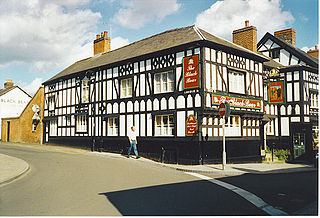
Whitchurch is a market town in the civil parish of Whitchurch Urban, in the north of Shropshire, England. It lies 2 miles (3 km) east of the Welsh border, 2 miles south of the Cheshire border, 20 miles (30 km) north of the county town of Shrewsbury, 20 miles (30 km) south of Chester, and 15 miles (24 km) east of Wrexham. At the 2021 Census, the population of the parish was 10,141. Whitchurch is the oldest continuously inhabited town in Shropshire. Notable people who have lived in Whitchurch include the composer Sir Edward German, and illustrator Randolph Caldecott.
The year 1795 in architecture involved some significant events.

The Welsh Bridge is a masonry arch viaduct in the town of Shrewsbury, England, which crosses the River Severn. It connects Frankwell with the town centre. It is a Grade II* listed building.
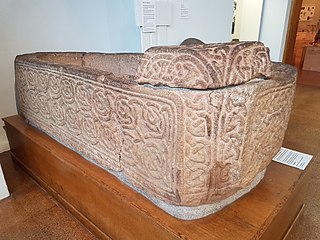
Alkmund of Derby, also spelt Ealhmund, Alhmund, Alcmund, or Alchmund was a son of Alhred of Northumbria, who was caught up in the kingdom's dynastic struggles.

Montford Bridge is a village and bridge. The village is in Shropshire, England, UK. The bridge is in that village. It lies on the River Severn and is close to the town of Shrewsbury.
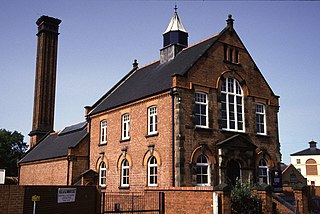
Coleham is a district of the town of Shrewsbury in Shropshire, England. It is located just south, over the River Severn, from Shrewsbury town centre.

Stoke on Tern is a village located in Shropshire, England, on the River Tern. The civil parish is known as Stoke upon Tern.

St Alkmund's Church is an active Anglican parish church in Whitchurch, Shropshire, England. By tradition, this church was founded in the 900s CE by the Anglo-Saxon Queen Æthelflæd. Certain sources suggest that the saint to whom it is dedicated, St Alkmund, (the son of Alhred, King of Northumbria, was first buried in Whitchurch.
This is a list of sheriffs and high sheriffs of Shropshire
William Hazledine was an English ironmaster. Establishing large foundries, he was a pioneer in casting structural ironwork, most notably for canal aqueducts and early suspension bridges. Many of these projects were collaborations with Thomas Telford, including the Pontcysyllte Aqueduct and the Menai Suspension Bridge.
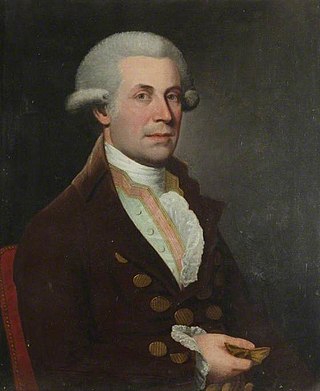
Thomas Farnolls Pritchard was an English architect and interior decorator who is best remembered for his design of the first cast-iron bridge in the world.

Shropshire is a county in the West Midlands region of England. In 2009, the historic county was divided into two unitary authorities, Shropshire and Telford and Wrekin. These two unitary authorities constitute the ceremonial county of Shropshire, which forms the basis for this list. The county's economy is largely agricultural. Until the creation of the new town of Telford in the 1960s, the largest town was its county town, Shrewsbury. Shropshire is the largest entirely inland county in England. Its churches are mainly constructed from local stone. This is mainly sandstone, although there are limestone deposits in the northeast of the county. The Triassic sandstone from quarries at Grinshill is considered to be one of the finest types of stone in the county for building.
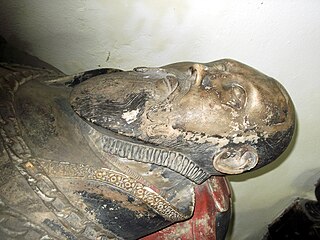
Sir Richard Newport was an English landowner and politician of Shropshire origin, prominent regionally during the mid-Tudor and early Elizabethan periods.

George Bromley was an English lawyer, landowner, politician and judge of the Mid-Tudor and Elizabethan period, a member of an important Shropshire legal and landed gentry dynasty. Although his career was overshadowed by that of his brother Thomas Bromley, George Bromley was of considerable importance in the affairs of the Welsh marches and the Inner Temple. He was an MP for Liskeard 1563, Much Wenlock in 1558 and 1559 and Shropshire in 1571 and 1572.

Edward Haycock Sr. was an English architect renowned for his work in the West Midlands and central and southern Wales during the late Georgian and early Victorian periods.

Reginald Corbet was a distinguished lawyer in four reigns across the mid-Tudor period, and prospered throughout, although he seems to have been firmly Protestant in sympathy. He was appointed serjeant-at-law and Justice of the King's Bench, and represented Much Wenlock in the parliament of 1542 and Shrewsbury in those of 1547, October 1553 and 1555. He enjoyed great wealth, partly because his wife was an heiress of Sir Rowland Hill, the first Protestant Lord Mayor of London.

John Brickdale Blakeway was an English barrister, cleric and topographer.

John Corbet (1751–1817) of Sundorne, was an English sportsman of the Shropshire landed gentry and politician who sat in the House of Commons from 1775 to 1780.